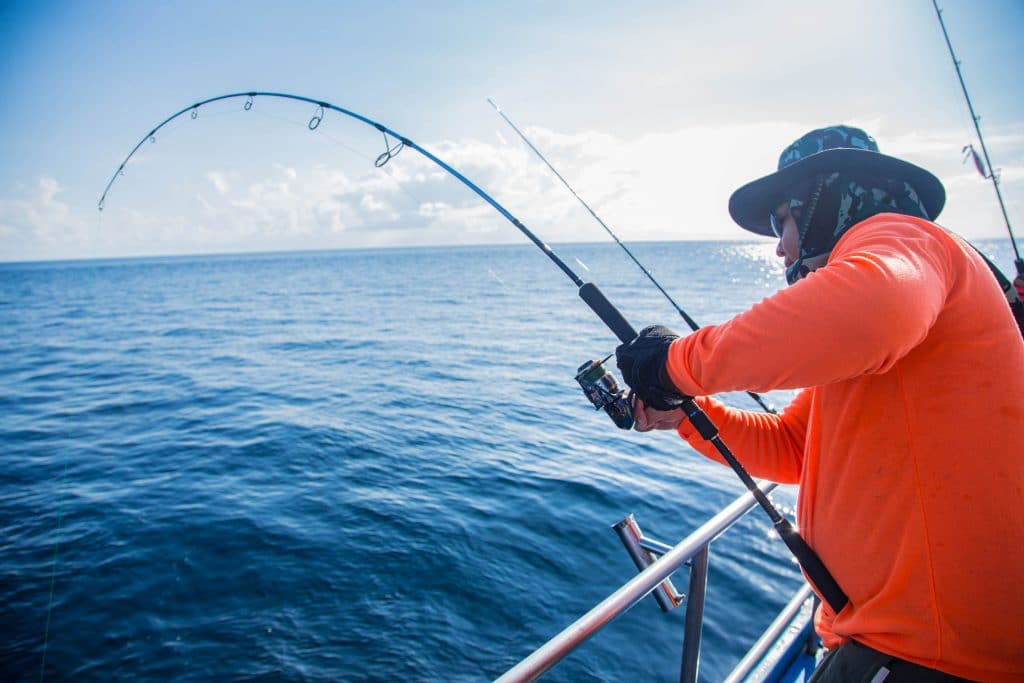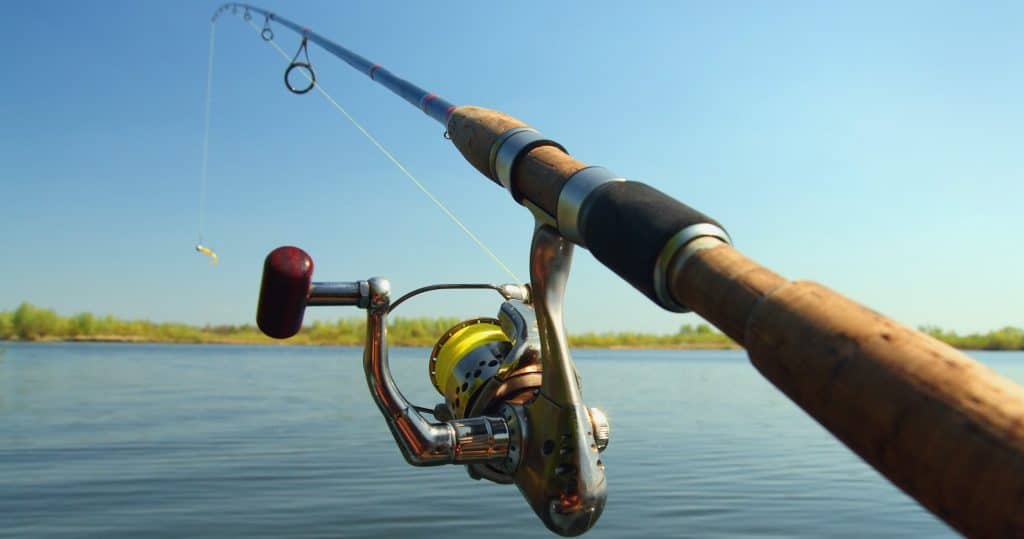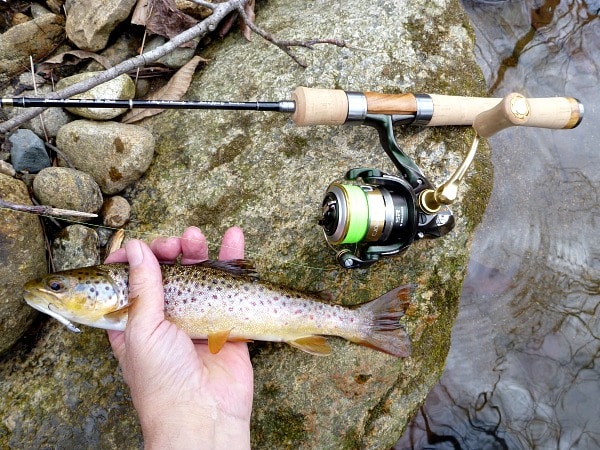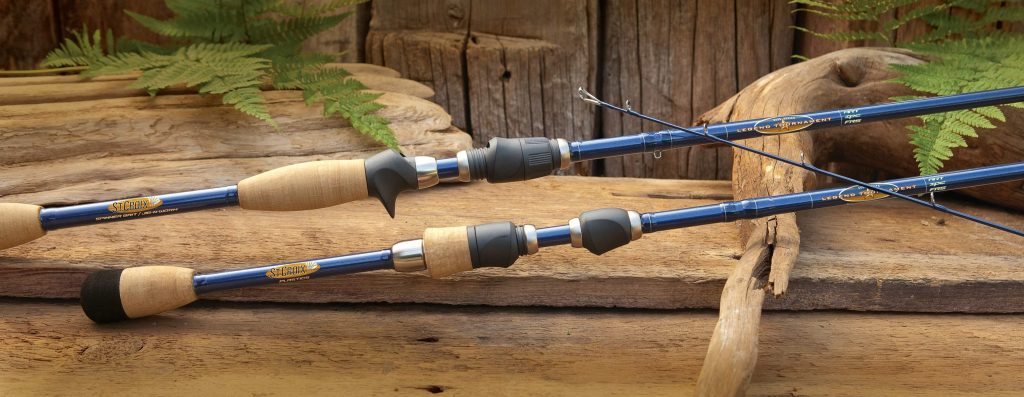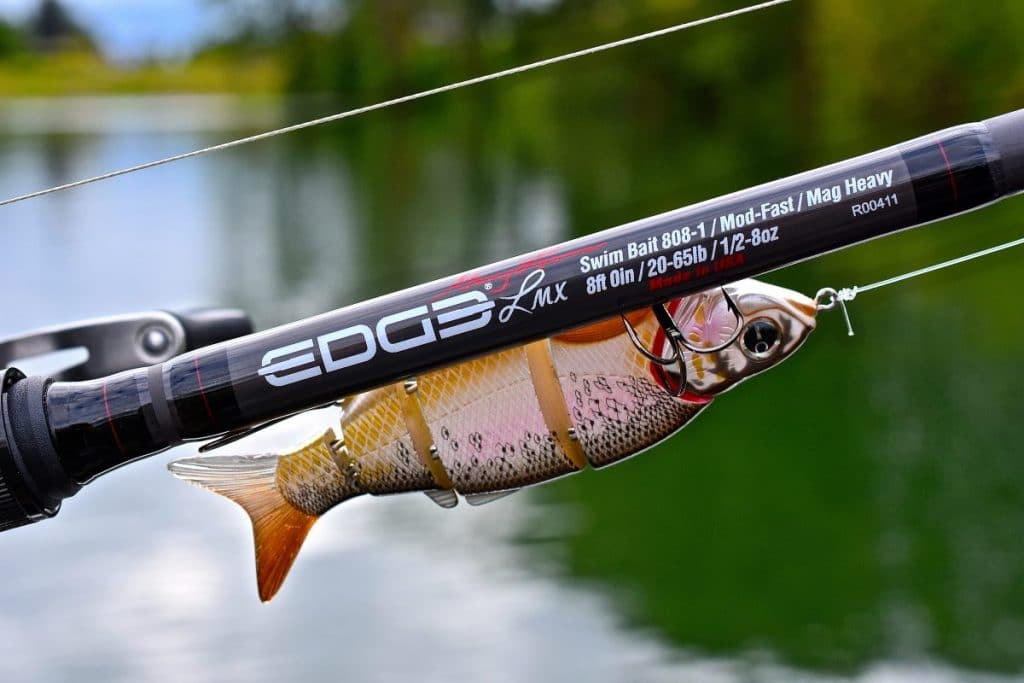

Any saltwater fisherman who has lost a battle with a big halibut knows the importance of a jigging rod. Jig fishing and jigging rods are specifically designed to help you land fish that live on the sea bottom and swim for dense cover once they’re hooked. To catch them, you need a rod that is comfortable enough to pull up and down over the course of a long struggle, yet burly enough to take the force of your line being wrapped around a rock.
To help you find the best jigging rod for your next fishing trip, we made a deep dive into the world of these fishing rods. Our research looked at jigging rods of different lengths, which are typically short so the rod won’t snap when fighting a fish. We also considered the rod action and power, which combine to give you the tugging force needed to reel in a fish without crippling your jigging rod. Based on this, the Tsunami TSSPJC-761XH Trophy was chosen as our Editor’s Choice. In addition, we looked at the weight of each jigging rod since you can easily get tired of holding onto a heavy rod for extended periods when reeling in a fish.
We spent tens of hours poring over technical specifications and customer reviews of the most popular jigging rods. The result is our list of the seven best jigging rods for any fishing style and budget, highlighted in the table below. Continue reading for detailed reviews of each rod, complete with pros and cons. Our buying guide covers everything you need to know about choosing the jigging rod that’s right for you. Finally, we sum up our three overall favorite jig rods for your next fishing trip. Quick Summary
Top 7 Jigging Rods Review 2025
More features: Fuji graphite reel seats, spiral wrapped guides, EVA grips
This jigging rod from Tsunami is significantly longer than your average jig rod, but it’s unique features make it an excellent choice for a wide variety of medium-sized fish like tuna and grouper.
The rod balances its 7’6” length by using an extra heavy power construction, which allows the rod to bend without breaking when you’ve got a big fish on the end of your line. Keep in mind that the action is only moderate, so this rod will be far less responsive to your movements than a typical jigging rod. While some fishermen appreciate this, it can be more difficult to make quick movements when you’re battling with a big fish.
The length of the rod, despite the extra heavy power, is also limiting in the size of lines and lures you can attach. The rod takes lines up to just 65 pounds and lures up to seven ounces – again, making it better for medium-sized fish in the 15–30- pound range than for catching “the big one.”
Users also found that while the graphite reel seat is lightweight, your reel can actually come off the seat if it’s not clamped down and you get into a battle with a heavier fish. Users recommend sticking with a narrow reel for this rod for that reason.
With that in mind, fishermen were extremely happy with how this rod performs under a wide range of conditions and appreciated the molded EVA foam grips for comfort. Plus, despite the overall length and power of the rod, users found that it was surprisingly lightweight and easy to jig with throughout a long day on the water.
More features: 316 stainless steel guide frames with Zirconium guide inserts, E-glass blanks, EVA foregrip
This powerful jigging rod is the best choice when it comes to pulling power, which makes it the ideal rod for fishing powerful species like tuna and snapper. The E-glass blank is lightweight and helps to reduce shock when a fish makes a break for it, especially if you use the rod with braided lines. Even better for using heavy-duty braided lines, the 316 stainless steel guide frames help to reduce friction as the line moves over the rod.
Okuma otherwise stuck with many of the hallmarks of jigging rod construction for the Cedros rod. The rod is just six feet long and has a stocky but that provides it with a heavy power rating. Although the action is not rated, users noted that it feels similar to a moderate fast action rod in responsiveness. The rod is surprisingly lightweight in user’s hands given how burly it looks and acts in the water, although users noted that it is still heavier than competitors like the Shimano Trevala. Still, users liked the EVA foregrip on the Cedros and felt that it was one of the most comfortable to hold rods on the market today.
Users also liked the anodized aluminum reel seat on this rod, which is extremely durable in the face of extended saltwater exposure. However, note that the reel seat is only designed for spinning rods, which somewhat limits your choices for pairing a reel with this rod. A final unique feature of this rod is that it comes with a limited lifetime warranty from Okuma.
More features: graphite reel seat with a rubber gimbal, Fuji N frame with aluminum oxide inserts, EVA foregrips
This relatively inexpensive jigging rod from Penn is the perfect all-around jigging rod for fishermen who like to fish a number of different species and in different environments. The rod features a moderate fast action and is available in heavy, medium heavy, and medium power designs. The tubular graphite composite blank construction is extremely lightweight given the sturdiness of the heavy version of this rod, and users appreciated the graphite reel seat that further minimizes weight.
The rod accepts lines and lures in the middle of the range, giving you more flexibility in what you fish. However, don’t expect to go after the heaviest snapper and rockfish with this rod, since you’re limited to lines rated 130 pounds and lures weighing 10 ounces. That said, users didn’t have any trouble using this rod and lines around 100 pounds in artificial reef environments and some users even report hauling in 50-pound fish with this rod. Better yet, users report that the rod is extremely durable and can be used in saltwater for several years before it shows any signs of wear and tear.
Users were overall happy with the performance of this rod in the water and felt that the EVA foregrip makes it extremely comfortable to hold. The rubber gimbal on the reel seat is also a nice touch, since it helps to prevent your line from becoming tangled while you’re reeling in a fish.
More features: GL2 graphite, composite cork and species cork blended handles
This jig rod from G Loomis is somewhat different from most of the other jigging rods we reviewed. Instead of going after saltwater halibut and snapper, this rod is made to fish for small trout in freshwater lakes and streams. The rod is incredibly lightweight, made from GL2 graphite and using a composite cork handle and butt to keep weight to an absolute minimum. This rod is also able to break down into multiple pieces to make it easier to hike into your favorite fishing spot with.
The specialization of this rod is obvious in its line and lure ratings. The rod is only designed to handle relatively lightweight lines up to six pounds and lures up to 3/16 ounces, so you’ll want to use maribou jigs or even live worm bait with this rod rather than standard saltwater jigs. The rod is also significantly longer than standard jig rods, at 7’2” in length.
Despite the lightweight and ultra-light power of this rod, users note that it’s surprisingly durable and fun to use. The rod is designed to protect your line from snapping when fighting with a medium-sized trout and can land surprisingly large fish without snapping. Users note that the rod does make even tiny fish feel like they’re putting up a huge fight – although for many fishermen, that’s a major part of the fun of using this rod. Plus, users loved that the fast action allows you to cast long distances easily with this jig rod.
More features: SLS3 blank construction, Fuji K guides with Alconite inserts; Pac Bay aluminum reel seat; aluminum gimbal
Users rave about this high-quality rod from Penn, which is designed as the perfect jigging rod for catching medium-sized fighting fish. The rod is virtually unbreakable thanks to the SLS3 one-piece blank construction and medium heavy power. At the same time, the rod sports a moderate fast action so that you can quickly respond to a fish’s bite without moving so fast that you jerk them right off the lure.
Users loved the feel of this rod, noting the difference compared to more budget-friendly rods like the Penn Rampage. For many users, the buttery smooth feel of jigging up and down with this rod, and the slight but powerful bend of the rod when fighting with a bottom-dwelling fish were well worth the price premium.
The line and lure ratings of this rod are what make it an ideal choice for the majority of medium-sized fish like bass, although it can also be used for larger grouper and snapper without too much trouble. The rod is able to handle line up to 130 pounds, including braided line, and can accept jig lures between five to eight ounces.
The non-slip foam foregrip on this rod was extremely comfortable for users, who also felt that it contributed to the overall balance of the rod in their hands. The Pac Bay aluminum reel seat is compatible with either spinning or casting reels and comes with a highly durable aluminum gimbal that can stand up to years of wear and tear on the rod.
More features: Ugly Tech Construction, higher graphite content, EVA handle
This inexpensive jigging rod from Ugly Stik is the ideal choice for fishermen just looking to start out with jig fishing. The rod is constructed with Ugly Stick’s patented Ugly Tech construction and supplemented with graphite to keep the weight to a minimum. In addition, the rod has a heavy power rating so that you can be confident in its ability to land a sizable fish when you sink the lure – users found that it can handle tremendous force without succumbing to the bend.
In many ways, this rod is the quintessential jigging rod – it is only about 6’3” in length and can handle lines up to 100 pounds. Users were happy with the EVA foam molded handle, which offers a firm grip and helps balance the rod so that you don’t get tired out too quickly. These characteristics offer versatility as well as make it easier to switch from this rod to another jigging rod when the time comes and you advance as a fisherman.
That said, there are some shortfalls of this rod compared to its more expensive competitors. Users found that the stripper guides could become cracked and loose, as well as begin to peel epoxy after a few days of exposure to saltwater. Some rods also had guides that were misaligned upon arrival, which makes it significantly harder to use the rod properly. Finally, users noted that the action – which isn’t rated for this rod – is a little bit slower than the typical jigging rod.
More features: TC4 blank construction, EVA grips, Fuji reel seat and guides
This lightweight and highly sensitive rod from Shimano is one of the best jigging rods for its buttery smooth jigging. The Trevala rod offers a moderate fast action and a heavy power rating, yet it’s amazingly light thanks to the TC4 carbon blank construction. Users were surprised at how effortless jigging for a long day on the water feels with this rod.
On top of that, the rod has staying power. Users found that pulling on the rod often worked to release jig lures from being stuck in rocks, and reeling in smaller ling cod and halibut was nearly effortless compared to other rods. The Trevala rod is also versatile thanks to its somewhat long 6’6” length and ability to accept lines from 80 to 200 pounds. Keep in mind that the rod is only designed for relatively large lures, though – it accepts lures that are 9.5 ounces at a minimum and is specifically designed to pair with Shimano Butterfly jigs that can be somewhat pricey.
The only issue that users found with this rod was the butt, which is made of relatively cheap plastic in contrast to the high-quality construction of the rest of the rod. Users noted that the teeth on the butt will wear out with extended use of the rod. Otherwise, users were happy with the comfort of the EVA foam grips and the Fuji reel seat that can be paired with either casting or spinning rods depending on your preference.
Now that you’ve learned more about our seven favorite jig rods, how do you choose between them to get the jigging rod that’s right for your style of fishing and budget? Our Buying Guide will explain everything you need to know about jig rods, from why you need one to the features you need to consider when choosing a new rod.
Fishing for bottom-dwelling saltwater fish such as halibut, grouper, snapper, and redfish presents several unique problems. First, these fish are somewhat shy biters – you need a hook that can stick to them despite this and yet still transfer the feeling of having landed a bite up to your rod. Second, these fish are fighters, and since they live on the bottom of the ocean there are plenty of rocks and other features for them to wrap your line around after they find themselves hooked. Together, these characteristics mean that you need a rod that is sensitive, but burly enough to wear down a big fish over the course of an hour-long battle.
Jigging rods were designed specifically with this purpose in mind. These rods are typically short and burly so that they won’t snap when fighting a big bottom-dwelling fish that has wrapped itself around a rod.
Jigging rods are also designed to accept massive line weights – in the case of our Editor’s Choice Shimano Trevala rod, up to 200 pounds – so that you can rest assured the fish won’t be able to cut your line.
At the same time, jig rods are lightweight and responsive. The typically fast actions allow you to quickly feel when your jig lure has been bitten by a fish and to sink the lure in your catch. And despite the strength of these rods, they are designed to be lightweight enough so that they won’t wear out your arms over the course of reeling in your fish.
These are all significant differences from standard fishing rods, which are thinner, longer, and not able to handle as much weight. Without a specialized jigging rod, you’re likely to either break your rod or your line in the process of reeling in one of these bottom fish, losing your lure and your catch in the process.
Jig rods are very distinct compared to other types of fishing rods, but there are a number of important differences among jigging rods that determine how you can use them. Here, we’ll take a look at the features you need to consider when choosing a jigging rod and how they can impact your fishing experience.
The majority of jigging rods are designed to be short and stocky – approximately six feet in length. However, you’ll also find longer jigging rods, like the 6’6” Shimano Trevala rod and the 7’2” G Loomis rod. These rods are longer because they’re designed to be used for jig fishing as well as other types of fishing, making them more versatile for different trips. However, keep in mind that longer rods may also be more prone to snapping if you try to reel in a particularly difficult fish.
The power of a jigging rod describes how much pressure the backbone of the rod can take without breaking. Since you’ll be using your jig rod to catch large, flighty fish like halibut and grouper, most jigging rods are designed with heavy or extra heavy power backbones. These heavy rods are capable of handling sudden pulls on the rod without snapping or giving out.
Keep in mind that power doesn’t necessarily relate to the durability and burliness of the rod – but you will also want a rod that is relatively durable.
Fish pulling your line around rocks can pull your rod in a number of directions, and your rod should be built to handle these forces.
The action is one of the most important features of every jigging rod because it determines how responsive the rod and lure will be when you move the rod up and down. If your jigging rod is too fast or too slow, you won’t be able to maintain a proper motion of the jig to attract fish and sink the lure when you get a bite.
The majority of jigging rods use moderate fast to fast actions, although some longer rods like the Tsunami jig rod use a moderate action to make them more versatile for other types of fishing. When choosing between a moderate fast and a fast action, consider how quickly you typically respond to receiving a nibble on your bait – with bottom-dwelling fish, there’s no time for delaying your pull up on the rod if you opt for a moderate fast action.
The line rating describes the weight, or thickness, or line that your rod is capable of accepting. Jig rods tend to accept heavier lines – up to 200 pounds in the case of the Shimano Trevala rod – since these are needed to withstand the abuse of being dragged around rocks by halibut and snapper. Keep in mind that jig rods that accept relatively light line weights, such as the Ugly Stik rod, may be better suited for shallow water fishing where there will not be as much line run out from your rod.
The lure rating describes the weight of jig that your jigging rod can handle. The lure weight should be interpreted as hard limits – exceeding the lure weight rating of your rod can damage your rod. Lure ratings can vary quite widely depending on how you plan to use your rod. Most saltwater rods accept lures up to seven ounces or heavier, since you’ll typically be fishing for relatively large and heavy fish. However, the G Loomis rod accepts lightweight lures only up to 3/16 ounces and is better suited for freshwater jig fishing for smaller fish, such as with worm bait.
The weight of your jigging rod is important in itself because it’s relatively easy to get tired when holding a heavy rod and fighting with a fish over the course of an hour or more. Moreover, jig fishing requires bobbing the bait up and down, so you can tire yourself out with a heavy rod even if you don’t catch anything.
For that reason, you’ll want to balance weight against durability, and consider how you plan to use the rod. If you expect to be out for long days, it will be worthwhile to opt for a lighter rod. Whereas if you take shorter trips in search of a big fish, you may be better off with a heavier, burlier rod.
Jigging rods are typically designed to be tough and durable, but they do break every now and then. When that happens, you’ll need to turn to the manufacturer’s warranty to see if the damage to your rod is covered. Warranties can vary widely among fishing rods, and in many cases you’ll need to contact the manufacturer directly to find out whether your rod has a warranty at all. But some rods, like the Okuma jig rod, are backed by a limited lifetime warranty.
Jigging rods can vary quite a bit in price, but it’s possible to get a high-quality jigging rod for as little as $80. On the higher end of the price range, you’ll find jigging rods for closer to $200.
Our three overall favorite jigging rods are the Shimano Trevala Jigging Casting Rod, the Okuma Cedros E-Glass Jigging Rod, and the Penn Rampage Jigging Spinning Rod. The Penn Rampage is a budget-friendly choice that is built with tubular graphite construction to give it a sizable dose of power while minimizing weight. The Rampage isn’t made for the biggest fish – it only supports line up to 130 pounds – but it will get the job done for most fish you’ll battle. The Okuma rod is distinguished by having a lifetime backing from Okuma, as well as an E-glass blank that is designed specifically for use with braided lines. Given the power, responsiveness, and comfort of this rod, it is one of the best choices for tuna jigging. We feel that the Tsunami Rod is the overall best jigging rod. is significantly longer than your average jig rod, but it’s unique features make it an excellent choice for a wide variety of medium-sized fish like tuna and grouper.
